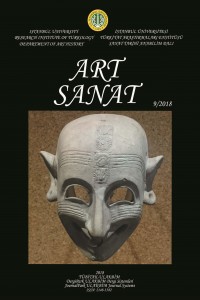Abstract
eykoz Kasrı, Beykoz ilçesinde Sultan Abdülmecid’e (1839-1861) armağan edilmek üzere yaptırılmış bir kasırdır. Kasır, İstanbul’da genellikle arazinin sahil kotunda bulunan düzlük alana bir yapı inşası, yamaç boyunca yükselen tepenin ise bir bahçeler kompleksi olarak kullanılması yaklaşımının aksine bir yerleşim düzenine sahiptir. Anadolu yakası üzerinde Avrupa yakası ve Boğaz manzarasına sahip bir tepe üzerine inşa edilen kasrın bahçeleri tepenin biçimine göre farklı büyüklüklerde beş set halindedir. Kasır ve bahçeleri bu niteliği ile özel bir değere sahiptir. Kasır ilk yıllarında bir biniş kasrı olarak kullanılmıştır. Sonraki yıllarda kullanımı kamuya geçen kasır sırasıyla yetimler yurdu, prevantoryum ve çocuk hastanesi olarak kullanılmıştır. Bu süreçte kasrın ve bahçesinin onarım çalışmaları gereğince yapılamamış, çevresel koşulların etkisiyle artan malzeme bozulmaları sonucu bahçedeki mimari öğelerde ciddi hasarlar meydana gelmiştir. 1999 yılında kasır TBMM Genel Sekreterliği’ne (Milli Saraylar) devredilmiş, bu tarihten sonra kasır ve bahçelerinde kapsamlı bir restorasyon çalışması başlatılmıştır. Günümüzde kasır müze olarak kullanımını sürdürmektedir. Bu
References
- Artan, Tülay. 1993. “Beykoz Kasrı”, Dünden Bugüne İstanbul Ansiklopedisi, İstanbul: Kültür Bakanlığı - Tarih Vakfı Ortak Yayını, 2: 199-200.
- Başbakanlık Osmanlı Arşivi (BOA), Hazine-i Hâssa Defterleri (HH.d), Defter: 31085. Başbakanlık Osmanlı Arşivi (BOA), Hazine-i Hâssa Defterleri (HH.d), Defter: 31358.
- Çetintaş, Vildan. 2012. “Türk Heykel Sanatının Gelişim Aşamasında Abdülaziz Dönemi (1861-1876) Etkinlikleri", 38. Uluslararası Asya ve Kuzey Afrika Çalışmaları Kongresi (ICANAS): Tarih ve Medeniyetler Tarihi, 10-15 Eylül 2007, Ankara: Atatürk Kültür, Dil ve Tarih Yüksek Kurumu Yayınları, 2: 925-935.
- Eldem, Sedat Hakkı. 1976. Türk Bahçeleri, Ankara: Kültür Bakanlığı.
- Evyapan, Gönül Aslanoğlu. 1972. Eski Türk Bahçeleri ve Özellikle Eski İstanbul Bahçeleri, Ankara: Orta Doğu Teknik Üniversitesi.
- Gülersoy, Çelik. 1970. Boğaziçi Koruları, İstanbul: Türkiye Turing ve Otomobil Kurumu.
- Günalp, Özlem. 2000. “Osmanlı Saray Bahçeleri”, Skylife Magazine, 200: 74-82.
- Seçen, Emine Atalay. 2011. “Son Dönem Saray Bahçelerini Süsleyen Heykeller”, Milli Saraylar Dergisi, 7: 19-41.
- Tarhan, Burçin. 1998. Dolmabahçe Sarayı’nın ve Aynalıkavak Kasrı’nın Türk Bahçe Sanatındaki Önemi ve Yeri, Yayınlanmamış Yüksek Lisans Tezi, Fen Bilimleri Enstitüsü, Ankara Üniversitesi, Ankara.
- Toğral, Tahsin. 2011. “Maslak Kasırları Yerleşim Düzeni ve Kullanımı Üzerine İnceleme”, Milli Saraylar Kültür-Sanat-Tarih Dergisi, 7: 131-151.
- Uğuryol, Drahşan, Mehmet Uğuryol. 2017. “Yıldız Sarayı Şehzade Köşkleri Bahçesi’nin Özellikleri ve Korunmuşluk Durumu”, Art-Sanat, 8: 261-289. http://ataturkkitapligi.ibb.gov.tr/ataturkkitapligi/index.php https://sehirharitasi.ibb.gov.tr
Abstract
Beykoz Pavilion is situated in Beykoz district and was built to be given to Sultan Abdülmecid (1839-1861) as a gift. The pavilion has a layout contrary to the approach of constructing a building in the plain area in coastal level in Istanbul and of using the hill rising along the slope as a garden complex. Built on a hill on the Anatolian side with European side and Bosporus view, the gardens of the palace are constituted of five terraces of different levels and sizes according to the shape of the hill. The pavilion and its gardens have a special value with this feature. The pavilion has been used for horse riding in its early years. In the following years, the pavilion has been served for public and used as orphanage, preventorium and children's hospital respectively. In this period, the repair work of the pavilion and its gardens was not carried out properly, and increased material deterioration due to the influence of environmental conditions has resulted in serious damage to architectural elements in the gardens. In 1999, the pavilion was entrusted to the General Secretariat of Turkish Grand National Assembly (Department of National Palaces). After this date, a comprehensive restoration work was started in the pavilion and its gardens. Today, the pavilion is being used as a museum. Within the scope of this study, design features and architectural elements of the gardens of the Beykoz Pavilion, changes in the gardens and its components over time were and their present state are evaluated. In order to determine the changes in the gardens in historical process, photographs, maps and plans in the archives are examined, past and present satellite images are compared, and these studies are reinforced with field survey to reveal the state of preservation of the gardens and architectural elements.
Keywords
historic gardens Beykoz Pavilion National Palaces preservation problems state of conservation
References
- Artan, Tülay. 1993. “Beykoz Kasrı”, Dünden Bugüne İstanbul Ansiklopedisi, İstanbul: Kültür Bakanlığı - Tarih Vakfı Ortak Yayını, 2: 199-200.
- Başbakanlık Osmanlı Arşivi (BOA), Hazine-i Hâssa Defterleri (HH.d), Defter: 31085. Başbakanlık Osmanlı Arşivi (BOA), Hazine-i Hâssa Defterleri (HH.d), Defter: 31358.
- Çetintaş, Vildan. 2012. “Türk Heykel Sanatının Gelişim Aşamasında Abdülaziz Dönemi (1861-1876) Etkinlikleri", 38. Uluslararası Asya ve Kuzey Afrika Çalışmaları Kongresi (ICANAS): Tarih ve Medeniyetler Tarihi, 10-15 Eylül 2007, Ankara: Atatürk Kültür, Dil ve Tarih Yüksek Kurumu Yayınları, 2: 925-935.
- Eldem, Sedat Hakkı. 1976. Türk Bahçeleri, Ankara: Kültür Bakanlığı.
- Evyapan, Gönül Aslanoğlu. 1972. Eski Türk Bahçeleri ve Özellikle Eski İstanbul Bahçeleri, Ankara: Orta Doğu Teknik Üniversitesi.
- Gülersoy, Çelik. 1970. Boğaziçi Koruları, İstanbul: Türkiye Turing ve Otomobil Kurumu.
- Günalp, Özlem. 2000. “Osmanlı Saray Bahçeleri”, Skylife Magazine, 200: 74-82.
- Seçen, Emine Atalay. 2011. “Son Dönem Saray Bahçelerini Süsleyen Heykeller”, Milli Saraylar Dergisi, 7: 19-41.
- Tarhan, Burçin. 1998. Dolmabahçe Sarayı’nın ve Aynalıkavak Kasrı’nın Türk Bahçe Sanatındaki Önemi ve Yeri, Yayınlanmamış Yüksek Lisans Tezi, Fen Bilimleri Enstitüsü, Ankara Üniversitesi, Ankara.
- Toğral, Tahsin. 2011. “Maslak Kasırları Yerleşim Düzeni ve Kullanımı Üzerine İnceleme”, Milli Saraylar Kültür-Sanat-Tarih Dergisi, 7: 131-151.
- Uğuryol, Drahşan, Mehmet Uğuryol. 2017. “Yıldız Sarayı Şehzade Köşkleri Bahçesi’nin Özellikleri ve Korunmuşluk Durumu”, Art-Sanat, 8: 261-289. http://ataturkkitapligi.ibb.gov.tr/ataturkkitapligi/index.php https://sehirharitasi.ibb.gov.tr
Details
| Primary Language | Turkish |
|---|---|
| Journal Section | MAKALELER/ARTICLES |
| Authors | |
| Publication Date | December 12, 2018 |
| Submission Date | December 12, 2018 |
| Published in Issue | Year 2018 Issue: 9 |


